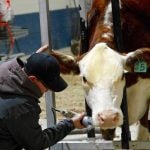High-density upright beans worth a try
High-density plantings of upright dry beans can improve yields without increasing white mould disease in the crop canopy. Choosing the most appropriate cultivar is important, however, because upright lines are not equal in their ability to escape white mould.
Upright blacks, navies and kidney beans are available and growers may want to try test strips of high-density plantings before deciding on a cultivar for large-scale production.
White mould is the most damaging disease of dry beans on the Canadian Prairies. Its severity increases with high humidity, periods of dampness and poor aeration typical of viny bean cultivars that lie on the ground, forming a dense canopy.
Read Also

VIDEO: Ag in Motion documentary launches second season
The second season of the the Western Producer’s documentary series about Ag in Motion launched Oct. 8.
To reduce the impact of white mould, the bean breeding program at the Lethbridge Research Centre is developing upright cultivars adapted to Western Canada. Upright beans are erect, have few branches and produce a narrow crop canopy that decreases white mould by preventing contact of leaves and pods with the soil.
Yields of upright beans grown at conventional planting densities (15 to 25 plants per square metre) in wide rows may not be maximized because the crop canopy does not always achieve full ground coverage. There is considerable producer interest in growing high density, upright beans in rows 15 to 25 centimetres apart.
At high densities and close row spacing, the beans can compete with weeds and use available sunlight to produce greater yields. In these close row spacings, however, anticipated gains in yield might be lost to increased incidence of white mould because of reduced air flow through the canopy.
Scientists at the centre compared yield and disease avoidance of four upright bean lines planted in narrow rows and at various densities. The disease incidence in the viny check cultivar was always severe, but upright lines always had less white mould than the viny control cultivar at all planting densities.
Although disease incidence increased in the upright lines with increases in planting density, it rarely exceeded a moderate level. Yields increased on a linear basis with planting density. A 10 to 20 percent yield advantage was obtained at a density of 60 plants per square metre.
Higher yields may be possible at higher planting densities, but the most economic planting density for upright beans depends largely on the cost of seed.
– Agriculture Canada
Hay shortage in U.S.
Despite record hay production, United States livestock operators continue to face relatively tight hay supplies. Hay prices in 1995, although slightly lower than last year, still average $75 to $78 per tonne nationwide, according to Livestock Marketing Information Center data. This is only a slight drop in prices from the 1994-95 crop year, the highest on record when hay averaged about $79 per tonnne.
“While below year-ago figures, hay prices still are historically high,” said Derrell Peel, a livestock marketing specialist. “Hay prices have averaged more than $85 per ton ($77 per tonne) in only three previous years.”
Estimates of United States hay production suggest a record 1995 production level of about 142 million tonnes. Combined with carryover stocks, the total national hay supply for the 1995-96 crop year is about 161 million tonnes, the highest since the 1991-92 crop year.
“In addition, the size of the nation’s cattle herd continues to increase, indicating more hay consumption,” Peel said. “Combined with high corn prices and low calf prices, more producers than usual are attempting to make forage-based programs profitable for their operations.”
He said supply and use numbers suggest continued high hay prices, and large hay acreage increases aren’t likely in the near future.
“Hay acreage will compete with acreage needed for other crops. Corn, wheat and cotton also are all experiencing historically high prices. Thus, hay prices probably will remain relatively high.”
– Oklahoma State University














